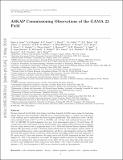ASKAP commissioning observations of the GAMA 23 Field
Abstract
We have observed the G23 field of the Galaxy AndMass Assembly (GAMA) survey using the Australian Square Kilometre Array Pathfinder (ASKAP) in its commissioning phase to validate the performance of the telescope and to characterise the detected galaxy populations. This observation covers ~48 deg2 with synthesised beam of 32.7 arcsec by 17.8 arcsec at 936MHz, and ~39 deg2 with synthesised beam of 15.8 arcsec by 12.0 arcsec at 1320MHz. At both frequencies, the root-mean-square (r.m.s.) noise is ~0.1 mJy/beam. We combine these radio observations with the GAMA galaxy data, which includes spectroscopy of galaxies that are i-band selected with a magnitude limit of 19.2. Wide-field Infrared Survey Explorer (WISE) infrared (IR) photometry is used to determine which galaxies host an active galactic nucleus (AGN). In properties including source counts, mass distributions, and IR versus radio luminosity relation, the ASKAP-detected radio sources behave as expected. Radio galaxies have higher stellar mass and luminosity in IR, optical, and UV than other galaxies. We apply optical and IR AGN diagnostics and find that they disagree for ~30% of the galaxies in our sample. We suggest possible causes for the disagreement. Some cases can be explained by optical extinction of the AGN, but for more than half of the cases we do not find a clear explanation. Radio sources aremore likely (~6%) to have an AGN than radio quiet galaxies (~1%), but the majority of AGN are not detected in radio at this sensitivity.
Citation
Leahy , D A , Hopkins , A M , Norris , R P , Marvil , J , Collier , J D , Taylor , E N , Allison , J R , Anderson , C , Bell , M , Bilicki , M , Bland-Hawthorn , J , Brough , S , Brown , M J I , Driver , S , Gurkan , G , Harvey-Smith , L , Heywood , I , Holwerda , B W , Liske , J , Lopez-Sanchez , A R , McConnell , D , Moffett , A , Owers , M S , Pimbblet , K A , Raja , W , Seymour , N , Voronkov , M A & Wang , L 2019 , ' ASKAP commissioning observations of the GAMA 23 Field ' , Publications of the Astronomical Society of Australia , vol. 36 , e024 . https://doi.org/10.1017/pasa.2019.16
Publication
Publications of the Astronomical Society of Australia
Status
Peer reviewed
ISSN
1323-3580Type
Journal article
Collections
Items in the St Andrews Research Repository are protected by copyright, with all rights reserved, unless otherwise indicated.

